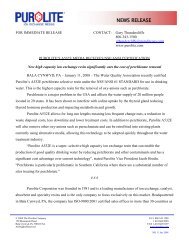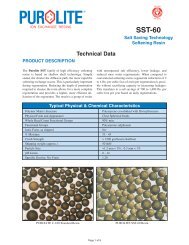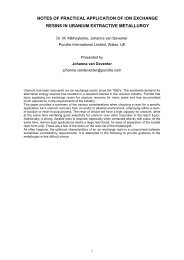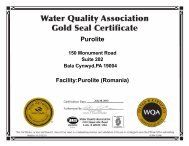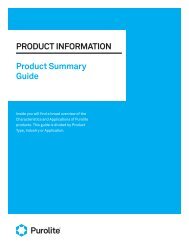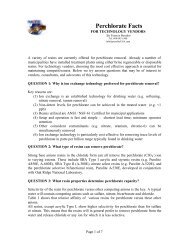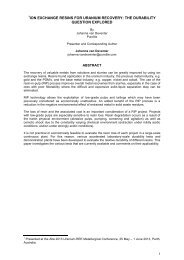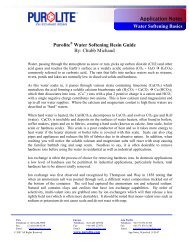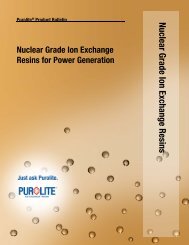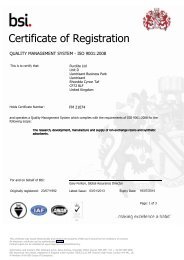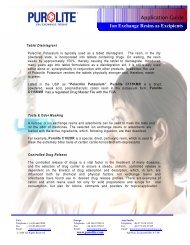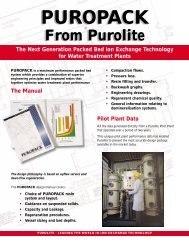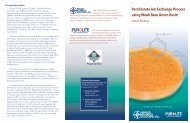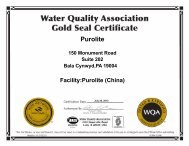Table 15: Reversible swelling<strong>Shell</strong>/Radius Ratio %Swelling1.0 std.70.6460.4612. <strong>Shell</strong>-<strong>core</strong> resin resists accelerated oxidat<strong>ion</strong> 1 using 6% H 2 O 2 and 1000 ppm Fe +3 ,as a catalyst. The loss in resin solids and dry weight are equated with <strong>ion</strong> <strong>exchange</strong> resindecrosslinking that occurs naturally in commercial use (Table 16).Table 16: Accelerated oxidat<strong>ion</strong><strong>Shell</strong>/RadiusRatio% Resin SolidsLost% Resin DryWeight Loss1.0 std.0.725.92.9713. Acid-base cycling stability 1 increases with lower S/R ratio Table 17.Table 17: Accelerated acid/base stability<strong>Shell</strong>/Radius Ratio % Loss of Perfect Beads1.0 std.0 to 50.730 to 10.4004. Crush resistance 1 increases with lower S/R ratio (Table 18).Table 18: Crush resistance<strong>Shell</strong>/Radius Ratio Average Breakpoint,g/bead0.972930.792900.733220.603785. The size uniformity of copolymer beads increases (lower UC) with initial shellsulfonat<strong>ion</strong> to a point where the S/R ratio is about 0.5, after which the uniformity decreasesagain when proceeding onward towards full funct<strong>ion</strong>alizat<strong>ion</strong> (S/R ratio = 1).12
Table 19: Bead size uniformity<strong>Shell</strong>/Radius Ratio Uniformity Coefficient0.00 copolymer1.370.481.160.501.150.641.281.00 std. resin1.533. RESULTSThe theses proposed in the Introduct<strong>ion</strong> are substantiated individually with specificexamples, all commercially related. Generally, <strong>ion</strong> <strong>exchange</strong> resin made with deeplyfunct<strong>ion</strong>alized shells and impervious <strong>core</strong>s is shown to operate more efficiently, particularlyin regenerat<strong>ion</strong> efficiency and subsequent effluent quality. This concept is broadened toinclude SAC, WAC, and SBA <strong>ion</strong> <strong>exchange</strong> <strong>resins</strong> and suggests it can be broadened furtherto all absorbents. Further, the resin beads have superior stability in normal <strong>ion</strong> <strong>exchange</strong>resin cycling.AcknowledgementI must recognize all the organizat<strong>ion</strong>s that are using these SST <strong>resins</strong> and tookthe effort to document the results herein.REFERENCES1. Fries William, Superior performance of <strong>ion</strong>-<strong>exchange</strong> <strong>resins</strong> with short, optimaldiffus<strong>ion</strong> paths – SDP <strong>resins</strong>, Reactive Polymers, 19, 97-104 (1993).2. Fries William, Ion <strong>exchange</strong> <strong>resins</strong>, European Patent EP0361685, 01/19/19943. Downey Don, SST-60 Shallow <strong>Shell</strong> Strong Acid Cat<strong>ion</strong> Resins, <strong>Purolite</strong>.com.4. Heller Terence, Iron Removal with SST Ion Exchange Resins, <strong>Purolite</strong>.com.5. Boodoo Francis, Enhancing RO Permeate Recoveries with Cyclic Ion Exchange, IWCSan Antonio, TX, IWC 10-56.6. Downey Don, Use of Seawater to Regenerate PUROLITE R SST-80 Shallow <strong>Shell</strong>SAC Resin, IWC 11-06.7. Downey Don, Producing High-Purity Water with Shallow-<strong>Shell</strong> Resins, UltrapureWater, 18(6), 20, 22-24,26 (July/August 2001).8. Anon, Demineralizat<strong>ion</strong> Cost Reduct<strong>ion</strong> News, Reported independently byDemineralizat<strong>ion</strong> Cost Reduct<strong>ion</strong> News, Div. Indumark, New York, NY, February2009.9. Case History, SST-60 Shallow <strong>Shell</strong> Strong Acid Cat<strong>ion</strong> Resin.13



